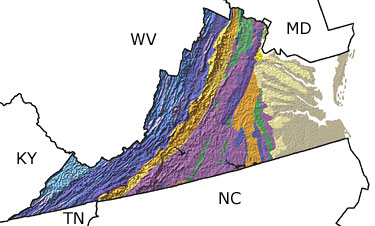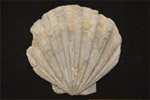Virginia, US
|
|
|||||||||||||||||||||||||||||||||||||||||||||||||||||||||||||
Paleontology and geology
The Precambrian: Metamorphosed Precambrian sedimentary rocks occur in the Blue Ridge Province of Virginia, but no fossils have been positively identified from these deposits thus far.
The Paleozoic: Paleozoic rocks are well represented in Virginia. Episodes of deposition in shallow seas were interrupted by mountain-building events and subsequent periods of erosion. Cambrian and Ordovician sedimentary rocks contain abundant marine fossils, indicating the presence of warm, shallow seas. During the Late Ordovician, a mountain-building event, the Taconic Orogeny, raised mountains to the northeast. By the Silurian, the Taconic Mountains had eroded away, and Virginia was again covered by a warm, shallow sea. Another episode of mountain building and subsequent erosion occurred during the Devonian. During the Carboniferous, the climate in Virginia was still warm. Fossils of “scale trees” (lycophytes) provide evidence of large coastal swamps that eventually produced Virginia’s vast coal seams.
The Late Paleozoic and Mesozoic: The retreat of the extensive shallow seas of the Paleozoic left much of the state exposed during the Permian and Mesozoic. In central Virginia, fossils of dinosaur footprints, freshwater fish, and insects are found in rift basin deposits of the Triassic. In the eastern part of the state, where the sea had not yet retreated, fossil oysters and belemnites have been recovered from a few Cretaceous outcrops.
The Cenozoic: Dramatic changes in sea level occurred throughout the Cenozoic. The rise and fall of sea level is recorded in the richly fossiliferous rocks of Virginia’s Coastal Plain. Amazing numbers of fossil clams, snails, and sand dollars can be found in these marine rocks, along with fossilized whale bones and shark teeth. Mastodon fossils, while not common, can be found in Quaternary sediments that were deposited along rivers and lakes.
Links to more on Virginia paleontology
ResourcesMuseums (showing 1 of 1 listings)
Updates from the VMNH Vertebrate Paleontology Lab: Current activities from the Virginia Museum of Natural History Paleontology Department, and information about fossils and geology, updated by Dr. Alton “Butch” Dooley.
Colleges and Universities (showing 1 of 1 listings)
Geobiology Research Group, Virginia Tech: A website of a paleobiology research group in the Ph.D.-granting Department of Geosciences at Virginia Tech. Also provides links to open-access websites of undergraduate and graduate level courses in paleontology as well as current research and publications.
Field Guides (showing 1 of 1 listings)
Fossils of Virginia: This site provides information and images of fossils found in Virginia with many other links to information on the geology of the state.

